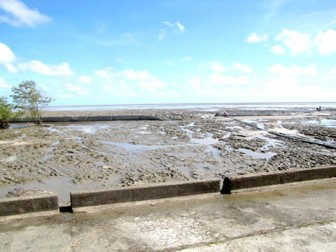-aims to protect mangrove seedlings from wave erosion
Agriculture Minister Dr Leslie Ramsammy says he is confident that the $26 million geotube/breakwater technology being tested at the Victoria mangrove site will be a significant boost to sea defence.
Ramsammy made these comments when he and a team comprising CEO of the National Agriculture Re-search and Extension Institute Dr Oudho Homenauth and other technical staff from the Guyana Mangrove Restoration Project inspected the site at the East Coast Demerara community last week.

According to a Government Information Agency (GINA) press release the geotube technology is a high strength woven plastic fabric container that is pumped full of sludge and placed in the sea to serve as storm-surge protection. They are generally used in shoreline protection. Two of these 50-metre long containers have been placed 100 feet away from the sea defence at the Victoria mangrove site at 150 degrees to the magnetic North which put them adjacent to waves and allow them to break the wave and to provide a hospitable habitat for mangrove restoration.
“The initiative is simply to ensure that the waves do not cause destruction to the mangroves… the geotube will diminish the impact of the wave and allow the mangroves to develop,” Ramsammy said. The area where the technology is being tested is devoid of mangroves; newly planted seedlings were destroyed by wave erosion.
This the first time this technology is being used locally and as such it will be monitored over the next six months to determine its effectiveness. “There will be continuous monitoring and at some point we will be able to determine whether geotextile technology can in fact enhance the growth and protection of mangroves so that mangroves can in fact be a major sea defence in our country,” Ramsammy said.
Further, he noted that “Our local engineering capacity within the ministry and outside of the ministry are quite capable of putting their heads together and accomplishing feats that many people doubt we can do,” he said, pointing out that the work is being executed by young people.
Project Engineer Renetta Robertson explained that the tubes are filled with slurry (water and sand mixture) that is pumped from a pit by a gravel pump that is normally used in the mining industry and which sends the slurry straight out to the tubes for them to be filled with sand.




